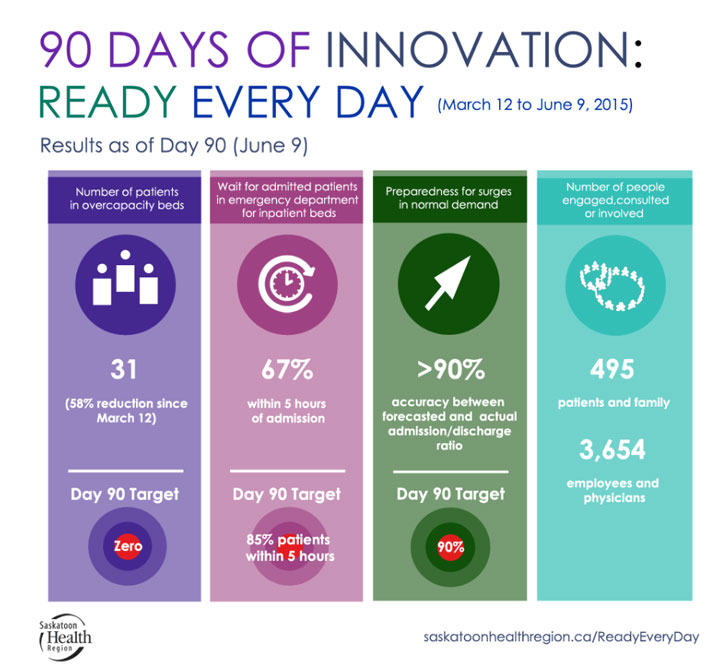Watch above: The Saskatoon Health Region is taking a look at whether or not its enthusiastic 90 day Innovation initiative worked. Meaghan Craig will bring us the latest.

SASKATOON – Three months worth of work has now come to a close but has the Saskatoon Health Region (SHR) found a cure for it’s overcapacity crisis?
On Tuesday, health officials presented the results of region’s “90 Days of Innovation”, an improvement to patient flow.
Dan Florizone, president and CEO of the SHR admitting if solutions were simple, it wouldn’t have taken 90 days and teams to tackle system-wide challenges.
READ MORE: Staffing shortages plague health regions, costing millions of dollars
The biggest challenge in 2015, chronic overcapacity in the SHR with patients being cared for in inappropriate spaces.
“It’s not acceptable to us, not acceptable to our staff and ultimately not acceptable for our patients,” said Florizone.
- Solar eclipse eye damage: More than 160 cases reported in Ontario, Quebec
- 3 women diagnosed with HIV after ‘vampire facials’ at unlicensed U.S. spa
- ‘Super lice’ are becoming more resistant to chemical shampoos. What to use instead
- Canadian man dies during Texas Ironman event. His widow wants answers as to why
On the heels of the region’s’ “14-Day Challenge” to curb overcapacity, SHR launched this latest innovation on March 12 and it ended on June 9. Three vice-presidents led three teams during that time and improvements have been made to the system.
“We have now gotten to a point where on some of the mornings that we come in we actually empty emergency department beds, sometimes just two or three are enough to make that difference but it certainly has gotten better,” said Ryan Baliski, manager of emergency at St. Paul’s Hospital.
A far cry from the way things were late last year in emergency departments, adds Baliski.
“We were consistently at a point into back hallways with MD ambulance, we had depending on the emergency department all of our beds were filled, we were consistently overcapacity struggling to move patients into inpatient beds.”
Predictive models now give health care providers the ability to provide care to patients in the right place at the right time.
“Now we have the daily snapshot that tells what the next seven days looks like, we’ve got to an accuracy of over 90 per cent so that we can be proactive in managing the demand,” said Nilesh Kavia, who leads the information and decision support team.
Health officials now have the capability at a glance to see what capacity is like at all three regional hospitals; St. Paul’s Hospital, Saskatoon City Hospital and Royal University Hospital.
“Which unit has available beds, how many patients do we have waiting in ER, what are the opportunities, how many beds do we have in the transition side so that’s available to us at any point in time and we’re starting to pull staffing information as well so that we can start to see how many shifts we have filled and how does that match to our capacity,” remarked Kavia.
SHR has also seen major gains as part of a community paramedicine pilot, five trained paramedics would respond to long-term care homes when they called for an ambulance transfer to hospital.
According to Cory Miller, also the lead for information and decision support, 15 hospital admissions from five sites were avoided.
An impact that could be huge if the model was applied to all 30 long-term care homes and 70 plus personal care homes in the region.
“We know that 1,240 of the transports happen from our long-term care facilities to our hospitals every year and 57 per cent of those turn into admissions, many times those admissions can be avoided all together by just sending that clinical support to the home to support the team and that resident in the home.”
Still as the 90-day cycle wraps, SHR revealed there were 31 patients in overcapacity beds and the target is zero.
Additionally, while 67 per cent of patients in the emergency department waited five hours or less for inpatient beds, the target for is 85 per cent.
“Sometimes this is viewed as more of a gestation period in other words it would take nine months for a baby to come full term no matter how much manpower or resource you throw at it.”
Florizone says the health region isn’t making excuses it will just take some time to get it right.


Comments